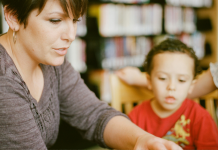From the very moment your eyes read that positive pregnancy test in your trembling hand, something changed in you.
One of your most basic instincts awoke like a hibernating mama bear and you felt for the very first time “I’m going to protect this child with all I am.” From pregnancy to birth to toddlerhood to walking across the stage to receive her college diploma, it’s unlikely this emotion will ever subside. It’s innate – the inborn feeling that you will go across the earth to protect her from any harm, pain, discomfort or sadness within your power. This is a beautiful picture of love.
You are to be commended for your hours and days and nights of putting the needs and safety of another human being (or several) ahead of your own. And while caring for your children is of utmost importance, it’s also crucial to note that care goes deeper than protecting them from every scrape and bump AND that imposing too many restrictions on young children can actually hinder development. For the rest of our time together let’s commit to the notion that.
The well-being of our children always means keeping them as safe as necessary, but not always as safe as possible.
It has often been quoted that, “Play is the work of children.” Play is how children learn. Play is how children experiment. Every little action a child does is a test in how the world works.
If I poke my baby sister in the eye, how will she respond? If I bounce the ball off the wall, where will it go? If I jump off this boulder, how will my body feel? Without the freedom of unstructured play and experimentation, children can’t learn appropriate risk-taking, and this can have huge impacts later in life.
Children must experience challenges and risks that they overcome themselves to learn how to deal with daily life experiences.
Think about it – a two-year-old bumps his head more times in a day than you do in a year. Children need daily opportunities to problem-solve in order to develop into strong, capable, resilient little humans that eventually become determined and capable members of society.
A reasonable risk is any action, activity, or behavior that starts with careful consideration and results in taking a leap toward the “edge of safety.” Safety is an objective term–what’s safe for one age, body type, or personality may not be “safe” for another. Focus on letting your child get to whatever her “edge” may be.
He starts that climb up the slide, the jump off the boulder, the leap from stone to stone and everything in you wants to scream, “No! Be careful! Get down–you’ll hurt yourself!” Next time, try the following approach:
Consider this acronym to work as a TEAM with your child.
Trust– Understand and believe that, developmentally speaking, children need to take physical sensorimotor risks to understand their body and the world around them.
Evaluate– Assess the risk. Decide if you believe this is something “at the edge” of safety for your child.
Ask– Instead of the typical, “Be careful,” try asking one of the following: “How does your body feel?” “Have you planned your next move?” “Do you feel stable?” “Do you need more space?”
Move– Supervise the action, be ready to assist, and give appropriate guidance. “Last time you made that big of a step you slipped. How will you make sure that doesn’t happen this time?”
Risk is not chaos or carelessness. Appropriate risk-taking will not cause harm to others.
Risk involves careful consideration and action and is so worthwhile as the learning benefits greatly outweigh the possibility of any negative outcome. Children who take physical risks when they are young learn that they are competent and able, that when they mess up, it isn’t a big deal, and that even big failures build fortitude.
Think of a time your child took a risk in the past. How did she learn in that moment? Give your child a little space to ensure these connections continue to be made, step back, and watch her soar.














Yes to all of this! I love it!! I grew up with a very cautious mom. As a result, I am personally a very timid person when it comes to trying new things… I get inside my head and tell myself I can’t do something even as simple as hopping from rock to rock in a creek. I try very hard on a daily basis to have a healthier balance between keeping my kids safe while still letting them explore and gain confidence in their own abilities. Confidence often leads them to making wiser choices when it comes to safety anyway.
Comments are closed.